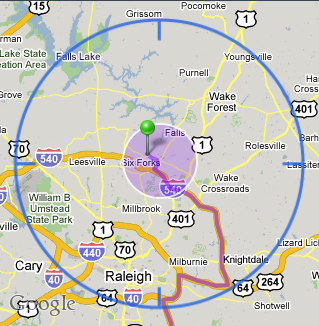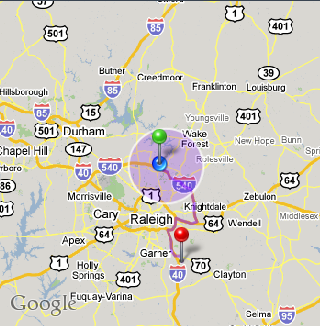Anand Reviews the Apple iPhone 3G
by Anand Lal Shimpi on July 16, 2008 8:00 PM EST- Posted in
- Smartphones
- Mobile
GPS.........kinda
The two major hardware changes to the iPhone are the inclusion of a 3G cellular modem and support for Assisted GPS (A-GPS). Despite what many have interpreted the name to mean, A-GPS is not in any way an inferior type of GPS, it’s simply a bit more efficient.
The deal here is that A-GPS relies on cellular data as well as an assistance server to help pinpoint where the A-GPS receiver is, when conditions are less than optimal. The standard iPhone can get a general idea of where you are based on what cell tower you are connected to, but the iPhone 3G with its A-GPS support can actually pinpoint you with much greater accuracy.
The fact that the iPhone 3G’s GPS is A-GPS isn’t its shortcoming, it’s the software that’s the problem. Like the original iPhone, the iPhone 3G ships with a version of Google Maps that works incredibly well with the iPhone’s multi-touch interface. Google Maps on the iPhone is almost as useful as a standalone GPS thanks to the speed of the interface, the problem is that you need a second person using it if you’re driving as it will give you turn by turn directions but won’t speak them to you.
The iPhone 3G unfortunately doesn’t fix this problem - the Google Maps software is identical to what shipped on the original iPhone. The iPhone 3G’s A-GPS will pinpoint your exact location, but it won’t combine with the turn-by-turn directions to automatically guide you to your destination. You still need to manually advance the directions. If you’ve got a someone with you, this is enough to make the iPhone 3G an even better car-navigation tool but if you’re alone it’s not much better than the old iPhone.

No GPS

GPS in action, precision baby
With the app store and the 2.0 SDK there’s a great chance that someone will come along and develop a voice-guided turn-by-turn navigation system for the iPhone 3G, but there is always the chance that it’d be something AT&T would want to sell as a service. Given that Apple has already ceded power to AT&T with the way the iPhone 3G is sold, I doubt there’s much Apple could do if AT&T really wanted to charge for such a thing.
The A-GPS is also currently used by both first and third party applications to help improve the experience. If an app tries to use the A-GPS you must first tell it that it is allowed to use your location (a process that is honestly very Vista User Account Control-like, but I get the security benefit). The iPhone Camera app can use the iPhone 3G’s A-GPS to tag your photos with geographical data, while applications like Urbanspoon can use it to help find restaurants nearby.
The only other major complaint I have about the iPhone 3G’s A-GPS is that it appears to be a CPU hog as the entire Google Maps interface stalls a lot more with it active. Thankfully it doesn’t appear to remain active after you’ve quit Google Maps (hooray for no background tasks?), but this is further proof that Apple needs more processing power in the iPhone. Intel had better hurry up with its Atom strategy, the iPhone is ripe for such a powerful core...










55 Comments
View All Comments
sprockkets - Wednesday, July 16, 2008 - link
Yeah, T-Mobile has better coverage than At&t? WTH? Just look at their maps. Do they even have 3G yet?Well, I guess I can trust Anand's experience. But, at least I can take my SIM card out and use my own phone. I guess you can just call Verizon and do the same thing, but with the majority being GSM, there is less of a selection for CDMA.
And of course, Apple is predictable as ever. They advertise every night the iphone on The Daily Show.
cocoviper - Thursday, July 17, 2008 - link
I think as the US and Europe reaches saturation CDMA will become much more competitive. It's what China and Brazil's network are built on, and given the next 10-15 years there will most likely be more cell phone growth and eventually more users there.brzgeek - Wednesday, July 23, 2008 - link
CDMA in Brazil??!! I'm Brazilian, and the last company that was a CDMA holdout (Vivo) gave up that particular battle and switched to GSM about a couple of years ago. Nowadays there isn't a single company selling CDMA phones in Brazil any more (though Vivo still supports CDMA due to its pre-GSM users who haven't switched phones). I suggest you check your sources, they seem to be seriously outdated.NA1NSXR - Thursday, July 17, 2008 - link
You're kidding right? I just spent a year in China and it is a nearly 100% GSM country. I don't even know where you get off saying China is CDMA so matter-of-factly.tayhimself - Wednesday, July 16, 2008 - link
Hmm... this is a great suggestion Anand. Have a yearly charge for both and somehow integrate them too.